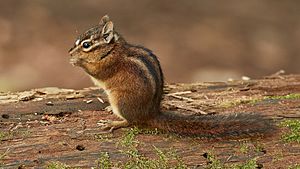Sonoma chipmunk facts for kids
Quick facts for kids Sonoma chipmunk |
|
|---|---|
 |
|
| Conservation status | |
| Scientific classification | |
| Genus: |
Neotamias
|
| Species: |
sonomae
|
 |
|
| Distribution of Neotamias sonomae | |
| Synonyms | |
|
Tamias sonomae |
|
The Sonoma chipmunk (Neotamias sonomae) is a small, furry animal. It belongs to the rodent family, just like squirrels. These chipmunks are special because they are found only in northwestern California in the United States. This means they are endemic to that area. Chipmunks in the Neotamias group have two premolar teeth. There are two types, or subspecies, of the Sonoma chipmunk: N. s. alleni and N. s. sonomae.
Contents
Where Sonoma Chipmunks Live
The Sonoma chipmunk lives only in California. You can find them north of the San Francisco Bay. Most of them live in Sonoma and Marin counties.
Sonoma Chipmunk Homes
Sonoma chipmunks like to live in forests or areas with chaparral. Chaparral is a type of shrubland with dense bushes. They can be found in forests with trees like sticky laurel, Ponderosa pine, Douglas fir, spruce, redwood, and black oak. They especially like coniferous forests, which have cone-bearing trees.
In chaparral areas, they often live where there are sagebrush plains. These chipmunks can live at different elevations, from sea level up to about 1800 meters (about 5,900 feet). They usually live on the ground and dig burrows. But they are also good climbers and might build nests in trees.
What Sonoma Chipmunks Look Like
Sonoma chipmunks are about 22 to 26.4 centimeters (8.7 to 10.4 inches) long, including their tail. Their tails are about 10 to 12.6 centimeters (3.9 to 5 inches) long. Their hind feet are 3.4 to 3.9 centimeters (1.3 to 1.5 inches) long. Their ears are about 1.5 to 1.9 centimeters (0.6 to 0.7 inches) long.
These chipmunks have five black or brown stripes along their body. White stripes run in between the darker ones. The rest of their fur, on their back and belly, can be tawny, cinnamon, or gray. Their tail has a white edge, and their belly is grayish-white.
Sonoma chipmunks change their fur twice a year. They have a summer coat and a winter coat. The winter fur is usually a bit darker and not as bright as their summer fur. The N. s. alleni subspecies is smaller and darker than N. s. sonomae. Male and female Sonoma chipmunks look very similar.
How They Compare to Other Chipmunks
Two other chipmunk species live in the same area as the Sonoma chipmunk. These are the yellow-pine chipmunk and the Townsend's chipmunk.
The yellow-pine chipmunk is smaller and less reddish than the Sonoma chipmunk. It also does not have a white-edged tail. The Sonoma chipmunk has longer ears, tail, and legs than the Townsend's chipmunk. It is also paler and has a bushier tail.
Their Skull and Teeth
The skulls of Sonoma chipmunks have a special bone shape called a post orbital process. This is found in all squirrel-like animals. Their skulls have a deep snout area and a long braincase. Their front teeth, called incisors, are curved like pincers. Their back teeth, or molars, are simple and have small bumps. These teeth help them eat their food.
What Sonoma Chipmunks Eat and Do
Sonoma chipmunks usually look for food on the ground. They also climb on small branches in bushes. They eat seeds, fruits, herbs, and buds from woody plants. They also eat insects and bird eggs. They collect food in their cheek pouches. Then they store it in their burrows for later.
These chipmunks often eat and rest in high places. This helps them watch for predators like hawks or snakes. Sonoma chipmunks make high-pitched, bird-like alarm calls. These calls are different from other chipmunks' calls. They make them when they sense danger. Females are usually the ones who make these calls. These calls likely help their family members stay safe. When a chipmunk hears an alarm call, it quickly runs to a safe, covered spot and stays very still.
These chipmunks go into a state called torpor in winter. Torpor is like a light sleep where their body slows down. They wake up sometimes to eat from their stored food. They don't store a lot of body fat like some other animals.
Sonoma Chipmunk Life Cycle
Sonoma chipmunks usually breed once a year. This can happen from February to July, but it's most common in April or May. Sometimes, a female might have a second litter if her first babies don't survive.
Pregnancy, or gestation, lasts for about 28 to 36 days. A mother chipmunk usually has 3 to 5 babies, but often it's 4. The babies are weaned (stop drinking milk) after about three weeks. After this, the mother stops spending time with them. The young chipmunks, called juveniles, stay together for a few more weeks. Then they spread out to find their own homes. Males usually travel farther than females.
Young chipmunks can start having their own babies within one year. These chipmunks live for about 64 months (a little over 5 years). Females tend to live longer than males. When young chipmunks first spread out in spring, there are usually equal numbers of males and females. But by the end of the year, there are more females. This is because males travel more and face more dangers. However, by the fall of their second year, the numbers become equal again. This is because first-year adult females face risks during their first time breeding. Over time, there will again be more females than males.
Images for kids
See also
 In Spanish: Neotamias sonomae para niños
In Spanish: Neotamias sonomae para niños




